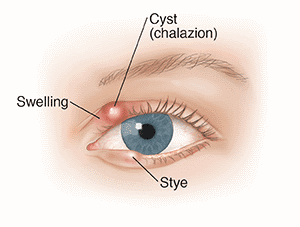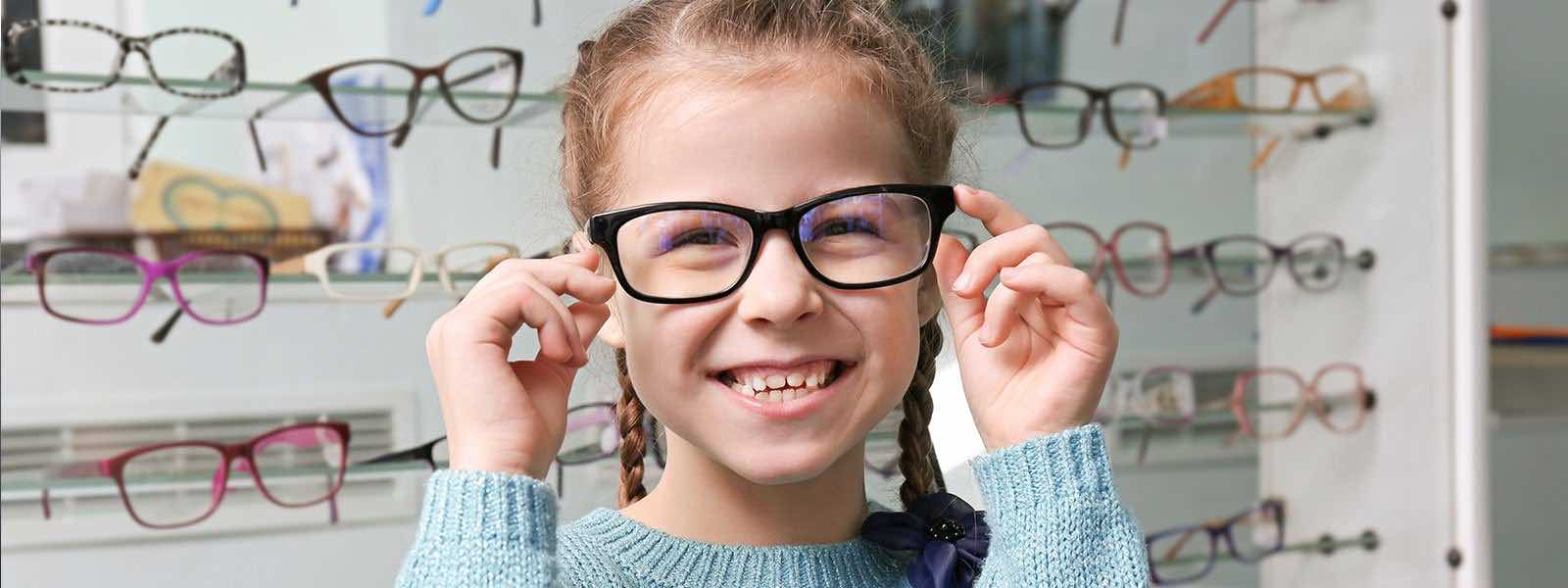What is a Stye & Chalazion?
The eyelid glands, known as meibomian glands, normally produce an oily substance that contributes to the natural tears on our eyes. If these glands become blocked, they could develop into a chalazion or a stye (i.e. hordeolum).
What is a Chalazion?
A chalazion is a large, non-infectious cyst in the eyelid that often takes several weeks to develop. It can be caused by either inflammation of the meibomian glands, or it can start as a hordeolum. A chalazion is not painful and usually occurs on the upper eyelid. This is likely because the upper eyelids anatomically have more glands (about 50 versus only 25 glands in the lower lid).
What is a Stye?
A hordeolum, also known as a stye, is often more acute and can be secondary to a bacterial infection of the eyelid glands. Styes are contagious but tend to be smaller, more painful, and more tender to the touch than a chalazion. If a stye is present for several weeks, it may develop into a chalazion.
There are two kinds of styes:
- External hordeolum: A stye that begins at the base of your eyelash. Most are caused by an infection in the hair follicle. It might look like a pimple.
- Internal hordeolum: A stye inside your eyelid. Most are caused by an infection in an oil-producing gland in your eyelid.
How to Recognize a Stye & Chalazion?
Stye symptoms can include:
- A very painful red bump along the edge of the eyelid at the base of the eyelashes. It may make the entire eyelid swell
- A small pus spot at the center of the bump
- Feeling like something is in your eye
- Scratchy feeling in the eye
- Sensitivity to light
- Crustiness along the eyelid margin
- Tearing in that eye
A chalazion can develop and you might not see any symptoms. When there are symptoms, they can include:
- A bump on the eyelid, sometimes becoming red and swollen. Occasionally it can be tender.
- Rarely, an entirely swollen eyelid
- Blurry vision, if the chalazion is large enough to press on the eyeball

What Is the Difference Between a Stye and a Chalazion?
Sometimes it can be difficult to tell the difference between a stye and a chalazion.
A stye is very painful. It often appears at the eyelid’s edge, usually caused by an infected eyelash root. It often swells, sometimes affecting the entire eyelid.
A chalazion is not usually painful. It is a bump that usually develops further back on the eyelid than a stye. It is caused by a clogged oil gland. Rarely does it make the entire eyelid swell.
Who is at Risk for Developing a Stye & Chalazion
Anyone can get a stye or chalazion. But you are even more likely to get one if you have:
- Blepharitis, a problem that affects the edge of your eyelid
- Had a stye or chalazion before
- A skin condition, such as acne rosacea or seborrheic dermatitis
- Diabetes or other medical problem
Stye & Chalazion Treatment
Before treatment can begin, our doctors will need to confirm that the lesion is truly a chalazion or stye and not another type of skin lesion. In general, there are several treatments available:
Warm Compresses and Antibiotics
A common home remedy is to place a warm compress over the affected area multiple times a day. This method can help melt the thickened oil gland secretions and can free the affected area, allowing it to function normally again. Our doctors will sometimes prescribe an antibiotic to the patient in order to combat the main infection. Oftentimes, these conservative treatment methods alone will allow the eyelid to heal, and no further treatment will be required.
If a patient has a recurrent chalazion or hordeolum, an extended course of low-dose antibiotic, typically a drug called doxycycline, may be prescribed to reduce chronic inflammation in the eyelids.
Steroid Injections and Surgical Removal
If a chalazion does not recede or if it continues to grow after a few weeks, either a steroid injection or chalazion surgical removal may be an option.
Steroid injections can be placed into the chalazion, thereby decreasing the inflammation, and leading to likely regression of the bump. This can generally be performed in the office.
Depending on the size and location of the lesion, another option to treat a chalazion would be to perform an incision and drainage procedure. If the affected area of the eye consists mostly of fluid, the bump can be punctured and then removed with pressure on the surrounding area. If the affected area is more solid, an eyelid incision will be required, and the sebaceous debris can be removed through the small incision. The surgery normally requires an incision from underneath the eyelid.
Recovery time from a stye or chalazion surgery is quick for most people. Some patients report minor discomfort or pain around the eyelid margin after the procedure, but this is typically remedied easily with medication. In most cases, an eye patch is worn over the eye for a few hours after the procedure in order to apply pressure to the surgical site to help prevent drainage from the affected area.
How to Prevent Chalazion or Styes
To prevent recurrent styes or chalazion, make sure to wash your hands frequently, take control of your contact lenses by practicing good hygiene, clean your skin and take care of your cosmetics. Make sure to throw anything away that is old to prevent any chance of infection and never share cosmetics with others.
Common Questions about Styes and Chalazions
Here are some common questions you can ask your Doctor.
How long does a stye last?
A stye is a minor, short-term bacterial infection that will last on average one to three days. Once the stye has drained on its own, the healing phase can last approximately 7-10 days. If your stye does not begin to clear up after a few days, it may be time to see a doctor.
Is a stye contagious?
The stye itself is not contagious; however, the bacteria that caused the stye can be transferred to others where it may or may not cause an infection. Just because the stye is not contagious doesn’t mean you should not be careful – we recommend maintaining good hygiene, do not wear any contact lenses, refrain from using public showers or pools when the infection is active, as well as not sharing personal items with others such as clothes, towels, razors or cosmetics.
How long does a chalazion last?
A chalazion typically lasts longer than a stye. They can take weeks to fully develop and depending on the treatment option, they can take more than a month to go away.
How do you know if a chalazion is healing?
A small chalazion will begin to reduce in size and go away on their own over the course of a few weeks without treatment. For larger chalazion, home remedies such as warm compresses or a gentle massage of the eyelid may help facilitate the healing phase. If the chalazion is persistent and there is no visible change in size after a few weeks, it will require treatment from a physician where they will prescribe antibiotics, inject a corticosteroid to allow better drainage, or use a local anesthetic to numb the area and make a small incision to clear the contents without visible scarring.
Contact SightMD today to schedule an appointment with one of our doctors to discuss your vision health at one of our convenient locations!

How Often Should My Child Have Eye Exams?
Ensuring your child’s eye health is vital for their overall well-being and development. Healthy vision significantly influences a child’s…

How to Prepare Your Eyes for the Colder Months
As temperatures decrease and the air grows drier, the colder months can significantly affect your eye health. To take…

Why Fall is the Ideal Season to Enhance Your Vision Before the Holidays with Cataract Surgery
Fall is a season of preparation—preparing for colder weather, the end of the year, and the approaching holidays. It’s…